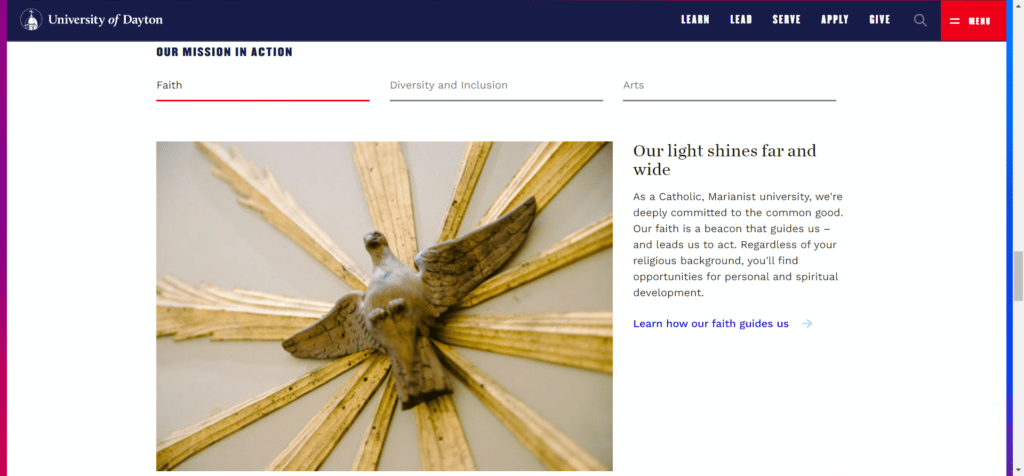AI Video Content Creation: How to Scale Authenticity and Engagement
Discover how AI video content creation in higher education boosts engagement, scalability, and student trust—without losing your authentic voice.
Branding
Is your higher ed website up-to-date and authentic to who you are? Learn how to strengthen your admissions funnel through authenticity in marketing.
A higher ed website is often a family’s first look into your college or university.
If you haven’t updated your website in three, six, or twelve months, the chances are you aren’t being authentic.
College and university campuses are dynamic.
It takes effort, but adjusting your online message to align with the dynamics of your on-campus feel is well worth it.
In this episode, my co-host, Troy Singer, and I interview Donnell Wiggins, Associate VP for Strategic Enrollment Management & Dean of Admission at the University of Dayton, about the importance of your higher ed website in communicating both authenticity and the truth that recruitment is everyone’s job.

While this maintained the core academic mission of keeping our higher ed institutions alive, it made it harder to get students on campus for a visit or even to enroll.
But traditional schools like the University of Dayton have beautiful campuses with robust resources as well as online courses.
There is so much a student will miss if they don’t come to campus and enroll in the full four-year college experience.
At this inflection point in higher education, we as institutions must ensure that we are highlighting our value proposition in a way that connects with families and students.
Families are making decisions not just based on those typical things we’ve seen in the past, but they’re also looking at a variety of [new concerns]. From a co-curricular standpoint, how will my mental health be managed? Will I feel a sense of belonging as it pertains to a community?
Families have a variety of options. Now, they have the option to maybe get a certificate or get a skill or trade. We as institutions must be diligent in terms of making sure our communication strategy aligns with the on-campus experience. How do we communicate to our families on the web in the same way as when they’re on campus in person?
To create a powerful value proposition, you have to be true to who you are.
As a faith-based institution, it would be easy for the University of Dayton to place its religious values in the background.

Source: https://udayton.edu/
But whether you’re a faith-based school or not, Donnell recommends treating your core values as a feature, not a bug.
It’s important that we as institutions highlight who we are and not stray away from it. At the University of Dayton, we are a Catholic Marianist institution committed to developing the whole person. We are true to that in our communication, and we’re true to that when students come on campus. It’s just so important that [both offline and online] messages line up well.
Even non-religious institutions have their unique purpose, goals, and values.
Staying true to those values, even if they touch on potentially sensitive topics, maintains the authenticity in your marketing so that what a prospective student family sees is who you really are in person.
Of course, authenticity in marketing and recruitment doesn’t have to come at the expense of diversity and inclusion.
As you can see, the University of Dayton allows their distinctly Catholic foundation to provide a welcoming environment to students and families who are also distinct in their values and beliefs.
Being true to who you are should also extend to the student so they can be who they are.
Authenticity in marketing doesn’t mean sacrificing inclusivity.
It means being transparent about the features of your institution that make you unique and really matter to you.
Out of the different marketing channels you have, your website may be the most critical in terms of authenticity.
You have to be diligent to make sure that it’s up to date regularly. Oftentimes, in many institutions, nobody’s checking the website. It’s so important that every three to six months institutions update their websites.
Many students are using the website as the first line of defense, the first point of contact. Not only is it the first point of contact, but it’s the follow-up point of contact. Because after [the student] comes to campus, they want to verify that what they saw or heard on campus is also on the website.
In my experience, this is true.
Prospective students and their families tend to do their research online through your website before deciding to come for a visit.
After the visit, they tend to go back to “verify” or remember what they saw and heard.
It’s essential that institutions are paying close attention to their website, not only from a mission perspective, but also from a faculty and co-curricular perspective.
One of the things we did was spend a significant amount of time with our faculty members [to determine] how we can strategically align our academic websites with our recruitment and admission website. [We wanted to] make sure that our academic websites were sufficient for our external audience [so that] our first-year students, transfer students, and international students receive the same message.
Not having this same message shows that there is a disconnect.
Spending time with your faculty, other academic units, your co-curricular entities, student development, and other entities on campus ensures that everybody understands that recruitment and enrollment is everybody’s job.
Recruitment and enrollment is everyone’s job because you never know when you as a faculty member, you as a staff member, or you as an administrator will walk in that grocery store, or walk in that department store and someone sees [your school’s branding on your] shirt.
How you engage with them [in-person must align with what the student will see when they] go back to the website. The website is so important to Gen Z. We have to do an outstanding job making sure that [authentic] message is carried through [online and offline].
Like all of our blog post reviews of The Higher Ed Marketer podcasts, there’s so much more to learn in the podcasts themselves.
Listen to our interview with Donnell Wiggins to get even more insights into:
You’re in luck! We’ve curated 25 awesome ideas inspired by top higher ed institutions across the country and put them in one handy guide: 25 Ideas for Great Admissions Content.

Get inspired.
Get enrollment results.
Get 25 Ideas for Great Admissions Content.
Download your copy today!
Featured image via udayton.edu
Subscribe to The Higher Ed Marketer podcast today!